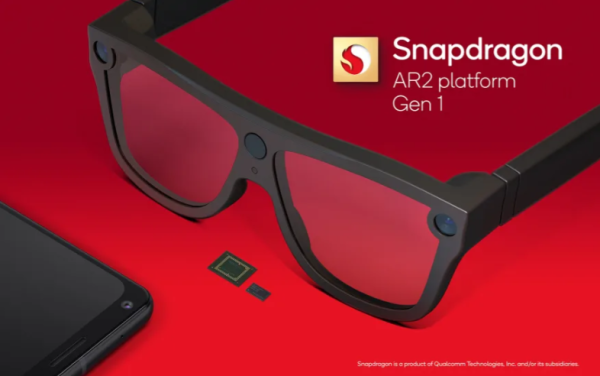New Snapdragon Platform Has Been Built for Slim AR Glasses
For augmented reality glasses to be accepted by the mainstream population, their form factors will have to be as close as possible to those of conventional sunglasses and prescription glasses. That will necessitate packing them up with chips that are powerful without requiring large batteries strapped to your head.
Qualcomm is heading in that direction in the evolution of its XR chips. Its Snapdragon AR2 Gen 1 platform has been built for small augmented reality glasses.

The AR2 Gen 1 has a multi-chip design that supposedly provides 2.5 times the AI performance over Qualcomm’s XR2-based reference design at half the power. The chip could enable the development of eyewear capable of intelligently detecting objects in the room inside a slim and light form factor that will enable the AR glasses to be used over an extended period of time.
According to Qualcomm, one of the ways it does this is by spreading the computing load across the frame of the augmented reality glasses. The primary 4nm-based processor consists of a CPU, graphics, Tensor AI processing as well as engines for features such as visual analytics.
The chip is capable of supporting up to nine simultaneous cameras used to track your body and the environment around the wearer.
There is also a co-processor located elsewhere in the AR glasses which has an AI accelerator to perform tasks such as computer vision and eye tracking. There is also a third chip that takes care of the connectivity to phones and networks. This provides better balance for the weight and also ensures smaller circuit boards as well as fewer wires than you’d require in a single do-it-all chip.
Qualcomm says networking will also be key. The Snapdragon AR2 Gen 1, just like the Snapdragon 8 Gen 2 used in smartphones, supports WiFi 7, one of the first platforms to do so. This is important in many ways. It offers massive bandwidth that allows the headset to be connected at speeds of up to 5.8Gbps. Qualcomm says the WiFi 7 support also reduces latency to your phone (to under 2ms).
When the lag reduction in the processor and the co-processor is factored in, users are assured of a more responsive and natural-feeling experience.
XR hardware that has been developed on the AR Gen 1 chip is currently in “various stages” of development by some of the leading XR hardware manufacturers such as Nreal, Lenovo, Xiaomi, LG, and Oppo.
Microsoft has also been instrumental in shaping the platform requirements and it is possible that AR might be used in virtual collaboration in some of Microsoft’s apps and services.
Qualcomm also added some meaningful updates to the audio technology in its platforms. It has introduced the new S3 Gen 2 Sound and S5 Gen 2 Sound platforms that should take the latest in listening technology such as lower latency for games, spatial audio, and adaptive active voice cancellation to the mainstream. Real-world products containing this tech will start arriving in the market in the second half of 2023.
One of the top benefits of the new audio technology is that features that were hitherto reserved for the pricier headphones and buds will now be available in affordable and accessible devices.
Source: Engadget
https://virtualrealitytimes.com/2022/11/18/new-snapdragon-platform-has-been-built-for-slim-ar-glasses/https://virtualrealitytimes.com/wp-content/uploads/2022/12/Qualcomm-Snapdragon-AR2-Gen1-Platform-600x376.pnghttps://virtualrealitytimes.com/wp-content/uploads/2022/12/Qualcomm-Snapdragon-AR2-Gen1-Platform-150x90.pngAugmented RealityTechnologyFor augmented reality glasses to be accepted by the mainstream population, their form factors will have to be as close as possible to those of conventional sunglasses and prescription glasses. That will necessitate packing them up with chips that are powerful without requiring large batteries strapped to your head. Qualcomm...Rob GrantRob Grant[email protected]AuthorVirtual Reality Times - Metaverse & VR
